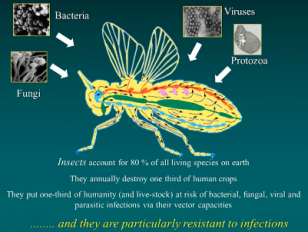Innate Immunity: From Flies to Humans

Presenter: Jules Hoffmann
Published: July 2014
Age: 18-22 and upwards
Views: 1809 views
Tags: gene;encoding;potent;antimicrobial;peptides
Type: Lectures
Source/institution: Lindau-Nobel
Watch now
Flies challenged with bacteria or fungi rapidly transcribe a battery of genes encoding potent antimicrobial peptides which oppose the invading microorganisms. Genetic analysis has identified two signaling cascades which control their expression: (1) the Toll pathway, activated in response to fungi and Gram-positive bacteria, has significant similarities with the Toll-like receptor (TLR) pathway in mammals, and (2) the Drosophila immune deficiency (IMD) pathway controls infection by Gram-negative bacteria, and exhibits stringent similarities with the mammalian TNF-Receptor pathway. The roles of innate immunity in both phyla will be discussed, as well as the origin of this first-line defense, which is now understood to have originated with the first multicellular organisms.



